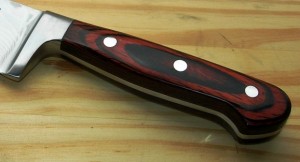 About a week ago, the Honolulu Star-Advertiser ran an interview with a Hawaiian chef who teaches at a local college. In the interview, chef Grant Sato shared some important tips everyone should remember when buying and using a knife.
About a week ago, the Honolulu Star-Advertiser ran an interview with a Hawaiian chef who teaches at a local college. In the interview, chef Grant Sato shared some important tips everyone should remember when buying and using a knife.
While most of his tips were useful, such as techniques to safely slice food and information on how to sharpen dull knives, he touched on a topic that is widely overlooked when selecting knives: the handles.
For kitchen knives and all types of knives for that matter, it’s important to carefully select the material of your knife’s handle. In the article, Sato made it clear that the handle is the most important part of a knife.
“The blades are all the same,” Sato says. “It’s the material of the handles that are different.”
There are four common types of handle materials, which include wood, composite, stag and metal. Each of these types has its own advantage and drawback.
For experienced knife enthusiasts, wood handles are the most preferred for kitchen knives because they are softer on the hands and protect against bacteria. However, they are harder to clean and don’t usually last for more than two decades.
Composite and metal knife handles are stronger, more durable and the most resistant to corrosion, making them better suited for survival knives.
Before buying your next knife, make sure you’ve thoroughly analyzed the pros and cons of the handle for the type of function your knife will serve.




Leave a Reply